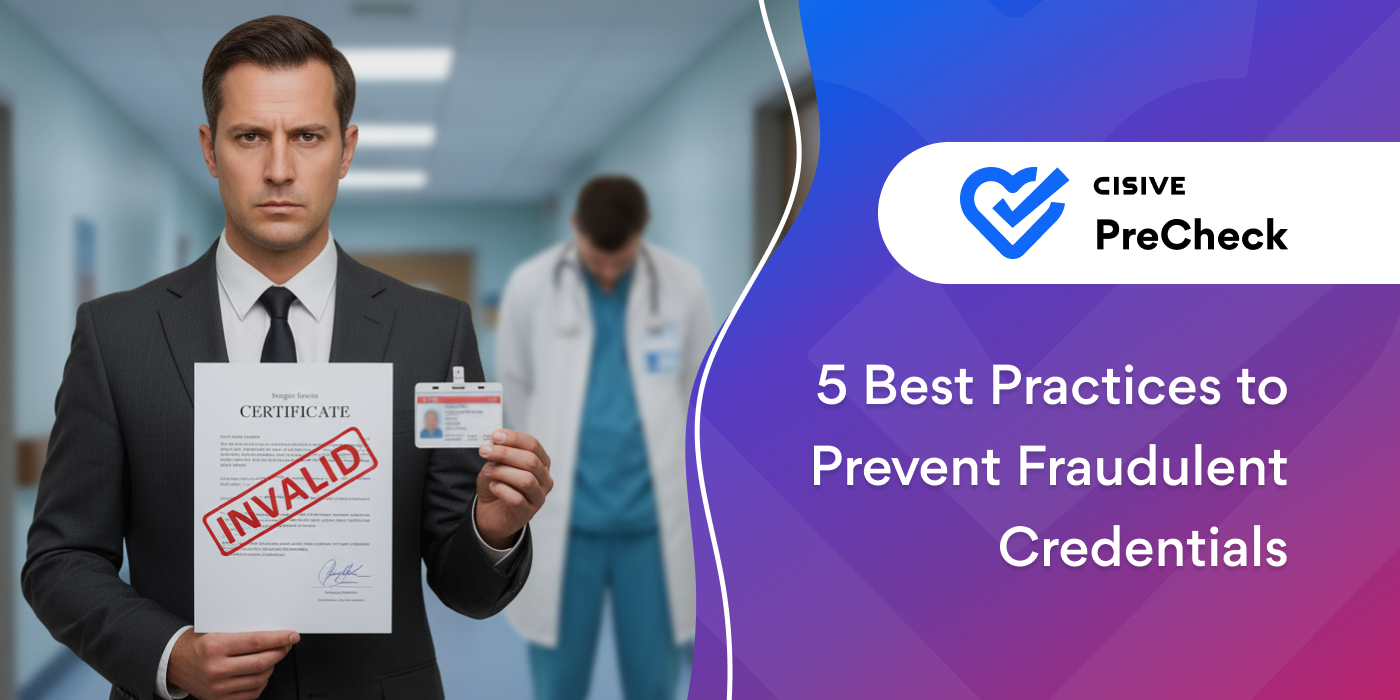

Imagine that you’ve just hired a new employee you’re excited to work with. They have impeccable...

Healthcare organizations face a dual challenge: filling critical positions quickly while ensuring every hire is fully credentialed and compliant. The pressure to move fast creates blind spots, and that’s where fraudulent licenses slip through. In recent years, cases of individuals using fake diplomas or fabricated credentials in healthcare have made headlines. Beyond these sensational stories, fake credentials ultimately put patients at risk, exposing hospitals to liability and drawing regulatory scrutiny.
For HR leaders, recruiters, and compliance officers, this isn’t a theoretical problem. A single fraudulent license to practice can lead to compromised patient safety, loss of accreditation, and reputational damage. The good news? With the right verification methods and best practices, employers can stop fraudulent licenses before they reach the floor.
Key TakeawaysHere are the five key things you need to know about how to spot a fake medical license:
|
Hiring fraud isn’t new, but in healthcare, the consequences are uniquely severe. Employers face growing pressure to bring qualified staff on board quickly. That urgency can open the door to fraudulent licenses. Fake credentials have become a calculated tactic that can compromise patient safety, violate compliance standards, and tarnish an organization’s reputation.
Across the healthcare industry, staffing shortages and rising patient demand have created a perfect storm for fraud. With open positions outpacing qualified applicants, recruiters often need to move quickly, and that speed can weaken verification checks. Fraudsters are exploiting this environment by presenting falsified diplomas, counterfeit licenses, or doctored paperwork.
Beyond operational risk, the business impact is significant. Organizations caught employing individuals with fraudulent licenses may face legal costs, delayed patient services, and reputational damage that undermines patient trust. High-profile cases of nursing diploma mills and falsified medical credentials highlight how widespread—and sophisticated—these schemes have become.
The compliance stakes are steep. Regulatory bodies such as The Joint Commission, NCQA, and state medical boards require strict primary source verification of licenses. Failing to identify fraudulent documentation can trigger audits, financial penalties, or even loss of accreditation. In some cases, hospitals have faced payer exclusions after fraudulent hires were uncovered.
Public trust is also at risk. Once news of a fake license surfaces, organizations may face not only regulatory action but also lawsuits, negative media coverage, and erosion of credibility with patients and staff. In regulated healthcare environments, a single oversight in credentialing can spiral into wide-ranging compliance violations.
Ultimately, fraudulent licenses jeopardize safety on the front line. A provider without valid credentials lacks the training and qualifications necessary to deliver safe, effective care. The risks range from misdiagnoses and medication errors to workplace hazards that put both patients and colleagues in harm’s way. Even if harm is avoided, the presence of an unqualified individual can destabilize team trust and morale.
Healthcare organizations cannot afford to view fraudulent licenses as rare anomalies. They are a growing hiring concern that intersects with workforce shortages, compliance requirements, and patient safety obligations. All of these demand proactive prevention.

Fraudulent licenses often share telltale signs. While not every irregularity confirms a fake, patterns of inconsistencies should trigger closer review. Training HR, compliance, and credentialing teams to recognize these signals is one of the most effective ways to prevent fraudulent hires. Here’s what to look for.
Official licenses issued by state medical boards follow a standardized format, with consistent seals, signatures, and typography. A document with blurred logos, uneven fonts, or missing security features should raise concern. For example, a license that appears photocopied or digitally altered may be a counterfeit created to bypass verification.
Every valid license can be confirmed with the issuing authority. If the license number, expiration date, or board details cannot be cross-checked with a state database, it’s a serious red flag. Employers should never accept a document at face value—especially if it comes from an unfamiliar source or institution.
Candidates who delay providing credentials, avoid direct questions, or attempt to rush the hiring process may be trying to conceal something. Hesitation to authorize verification checks or evasive responses when asked about gaps in documentation can signal fraudulent intent.
Patterns in a resume can also reveal risk. Frequent job changes, unexplained gaps, or roles inconsistent with claimed credentials may indicate falsification. For instance, a candidate who lists years of clinical experience without verifiable employers may be relying on fake documentation to cover those gaps.
Diplomas are often the foundation of fraudulent licensing schemes. Verifying the authenticity of educational credentials is just as important as validating active medical licenses, since a fake diploma may have been used to secure that license in the first place. Employers should take proactive steps to confirm that claimed degrees are legitimate and issued by accredited institutions.
The most direct method is reaching out to the registrar’s office of the claimed university. Many institutions have established verification services that confirm attendance dates, degrees earned, and graduation status. If the school cannot confirm the record, or if the institution itself is unaccredited or flagged as a “diploma mill,” that’s a clear sign of fraud.
Partnering with a background screening provider streamlines the verification process, ensuring that education checks are accurate and compliant. Providers specializing in healthcare maintain direct relationships with educational institutions, making it faster and more reliable to validate diplomas. For employers looking to strengthen this step, this guide to education verification explores how thorough checks can uncover discrepancies and prevent costly hiring mistakes.

Even when a license looks authentic, employers should never rely solely on physical documents. Verification must go beyond appearances to ensure credentials are valid, active, and in good standing. Several proven methods can help HR and compliance teams confirm a provider’s eligibility before extending an offer.
Primary Source Verification is the gold standard in healthcare credentialing. It means confirming license details directly with the issuing authority, such as a state medical board. This process removes the risk of relying on copies or applicant-provided documents, ensuring accuracy at the source. For example, PSV can confirm not only that a license is valid but also whether it carries restrictions or disciplinary actions.
Every state maintains a searchable database of licensed practitioners. These systems provide real-time updates on status, expiration, and disciplinary actions. Checking a candidate’s license against these databases ensures that the credential is active and compliant with state regulations.
Licenses need ongoing monitoring, not just one-time checks. Automated tools track changes to licensure status in real time, alerting employers to suspensions, expirations, or disciplinary actions. This reduces the administrative burden on HR teams and ensures compliance between audits or renewals.
Medical licenses are often tied to additional identifiers, such as DEA registration, NPI numbers, or specialty board certifications. Cross-referencing these credentials provides another layer of verification. Inconsistencies between records can reveal fraudulent activity or highlight areas requiring further review.

Spotting fake medical licenses requires structured, repeatable processes that make fraud detection part of everyday operations. By implementing consistent credentialing standards, training staff, and leveraging industry-specific expertise, healthcare organizations can stay ahead of increasingly sophisticated schemes.
A formal credentialing process ensures consistency across all hires. This includes verifying diplomas, conducting primary source verification, and documenting every step of the review. Standardization reduces the chance of oversight and provides audit-ready records if compliance questions arise. For example, hospitals often implement credentialing checklists to make sure no detail is skipped during onboarding.
Beyond compliance, a standardized process also creates operational efficiency. By setting clear expectations and workflows, organizations reduce delays, avoid miscommunication between departments, and streamline audits. Consistency doesn’t just catch fraudulent credentials earlier—it also accelerates onboarding for legitimate candidates.
Credentialing is only as strong as the people reviewing documents. HR and compliance teams should be trained to spot red flags such as unverifiable institutions, inconsistent resumes, or defensive applicant behavior. Ongoing education keeps staff informed about new fraud tactics, ensuring the organization remains vigilant.
Equipping staff with real-world examples and scenario-based training can strengthen this vigilance. For instance, mock document reviews or “red flag” case studies can sharpen their ability to identify discrepancies quickly. Regular refreshers ensure fraud detection skills evolve alongside new schemes.
Fraud prevention doesn’t end once a candidate is hired. Licenses can expire, be revoked, or face disciplinary action after onboarding. Employers that rely only on pre-hire checks risk compliance gaps. Continuous license monitoring ensures organizations are alerted immediately if a provider’s status changes, protecting patient safety and regulatory standing.
Continuous monitoring also provides peace of mind for leadership teams. Instead of reacting to problems after the fact, employers gain real-time visibility into provider status. This proactive approach can prevent compliance violations, reduce liability, and demonstrate to accrediting bodies that the organization prioritizes ongoing diligence.
Healthcare credentialing is uniquely complex, requiring compliance with multiple accrediting bodies and state regulations. General background check providers may not have the expertise needed to navigate these nuances. Partnering with a provider like PreCheck ensures license verification processes are tailored to the healthcare industry, supporting compliance with NCQA, The Joint Commission, and other standards.
Specialized providers also bring industry insights that general vendors can’t match. For example, PreCheck’s tools are built around healthcare workflows, offering automated alerts, real-time updates, and reporting designed for clinical environments. This alignment reduces administrative strain and ensures that compliance safeguards are practical as well as thorough.
Healthcare organizations operate in one of the most highly regulated environments, where compliance is non-negotiable. Employers turn to PreCheck because it offers healthcare-specific background screening that aligns with the requirements of NCQA, The Joint Commission, and state medical boards. Rather than piecing together generic services, PreCheck delivers a tailored solution that integrates seamlessly into credentialing and onboarding workflows. This ensures providers are properly vetted from day one and remain continuously monitored throughout their employment.
Beyond compliance, PreCheck reduces the administrative burden on HR and credentialing teams. Its ongoing license monitoring and primary source verification tools automate time-consuming tasks, freeing staff to focus on higher-value responsibilities. By combining technology, healthcare expertise, and real-time alerts, PreCheck gives employers confidence that every credential in their system is valid and up to date.
Healthcare organizations can’t afford to take risks with fraudulent licenses. From compliance fines to patient safety concerns, even one oversight can have lasting consequences. The strategies for how to spot a fake medical license in this blog post — spotting red flags, verifying through trusted sources, and standardizing credentialing processes — are essential steps for protecting both your workforce and your reputation.
PreCheck simplifies this process with healthcare-specific expertise, continuous monitoring, and seamless integration into your existing systems. Whether you’re hiring a licensed physician, onboarding a nurse, or maintaining compliance across an entire health system, PreCheck helps ensure every credential in your organization is valid and up to date.
Ready to strengthen your credentialing program? Speak to a PreCheck expert today to schedule a demo or consultation.
Author: Jenni Gallaway
Bio: Content Marketing Manager at Cisive. 8 years of experience in the background screening industry.
Let's Connect on LinkedIn
Imagine that you’ve just hired a new employee you’re excited to work with. They have impeccable...

Note: This article is about a product that is specific to employers hiring in the United States.

In this Cisive Product Highlight series, we’ll review key tools to consider when screening your...